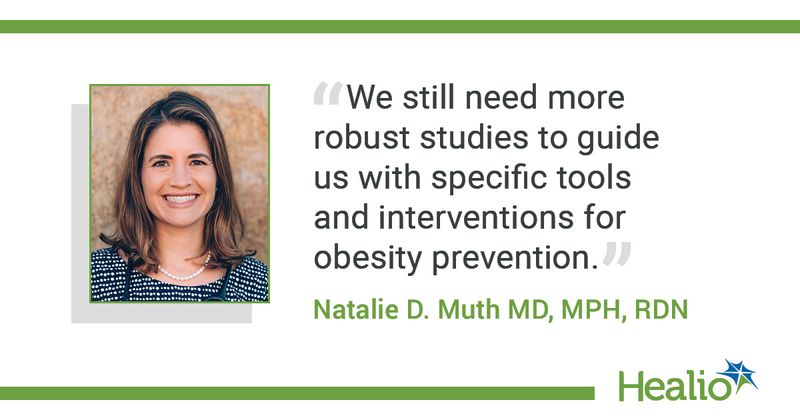Report offers strategies to help children, adolescents live healthier, active lifestyles
Key takeaways:
- An AAP report describes how parents and pediatricians can help children achieve healthier, more active lives.
- The report focuses on nutrition, physical activity, sleep, screen use and social-emotional wellness.
A new report from the AAP urges that pediatricians emphasize high quality nutrition, physical activity and adequate sleep, among other factors, to combat obesity in their patients.
Coauthored by the AAP Section on Obesity and AAP Committee on Nutrition, the new report is a complement to last year’s revised guidance on obesity, which suggested that physicians offer weight loss medication to adolescents aged as young as 12 years and evaluate teenagers for metabolic and bariatric surgery.

“We expanded the focus as the five key areas reviewed in the report: nutrition, physical activity, sleep, screen use and social-emotional wellness,” Natalie D. Muth, MD, MPH, RDN, a primary care pediatrician, registered dietitian and founder and director of WELL Clinic at Children’s Primary Care Medical Group in San Diego, told Healio. “[These] are critical not only in the prevention of obesity but also in optimizing good physical and mental health and helping children thrive.”
The AAP proposed a model of care that considers the environment in which a child lives — and how it can be made healthier, as well as interpersonal and individual factors that influence a child’s health.
“When it comes to obesity prevention, paying attention to the growth chart over time, and sensitively intervening early if there is crossing of percentiles, even if the child still has a ‘normal’ BMI, can be very helpful in recognizing concerns early, when small changes can make a big difference,” Muth said. “It is important to have these conversations in a sensitive way free of bias, blame or assumptions. The report provides clinicians with tools to do this as well as developmentally tailored guidance for each of the five domains.”
The report also advises that parents aim for an “authoritative” parenting approach in which they provide structure and environment to support healthy habits, and the children are given the responsibilities and choices within that structure, according to Muth.
“There is good evidence this parenting style supports improved physical and mental health for infants, children and adolescents, and the report provides developmentally-tailored ways to do this,” Muth said.
The authors also suggested that pediatricians offer guidance in a nonjudgmental manner, knowing the many social drivers underlying family life.
“Research tells us a lot about how to improve a child’s health,” Christopher Bolling, MD, FAAP, of the department of pediatrics at University of Cincinnati College of Medicine, said in a press release. “We know that families reap great benefits by eating together three times a week. We also have evidence that physical activity improves mental health and well-being. Once we identify a need, we can brainstorm practical ways that, as it turns out, benefit the whole family and not just children.”
Muth also told Healio that the guidance involves more than individual lifestyle changes, as families need community, policymaker and pediatrician support in assessing social determinants of health.
“We still need more robust studies to guide us with specific tools and interventions for obesity prevention,” Muth said. “I’d like for more studies of the health impacts of ultra processed foods to provide sound evidence that policy interventions are needed to reduce the consumption of these foods, especially for children and adolescents.”
More research is needed into how screen use and social media can influence child and adolescent health, according to Muth.
“Perhaps that can expedite policy interventions to help protect child and adolescent mental health and social emotional wellness,” Muth said.
References:
- American Academy of Pediatrics identifies keys to promote child health and help families aim for healthier lifestyles. https://www.aap.org/en/news-room/news-releases/aap/2023/american-academy-of-pediatrics-identifies-keys-to-promote-child-health-and-help-families-aim-for-healthier-lifestyles/. Published Feb. 26, 2024. Accessed March 1, 2024.
- Muth ND, et al. Pediatrics. 2024;doi:10.1542/peds.2023-065480.
